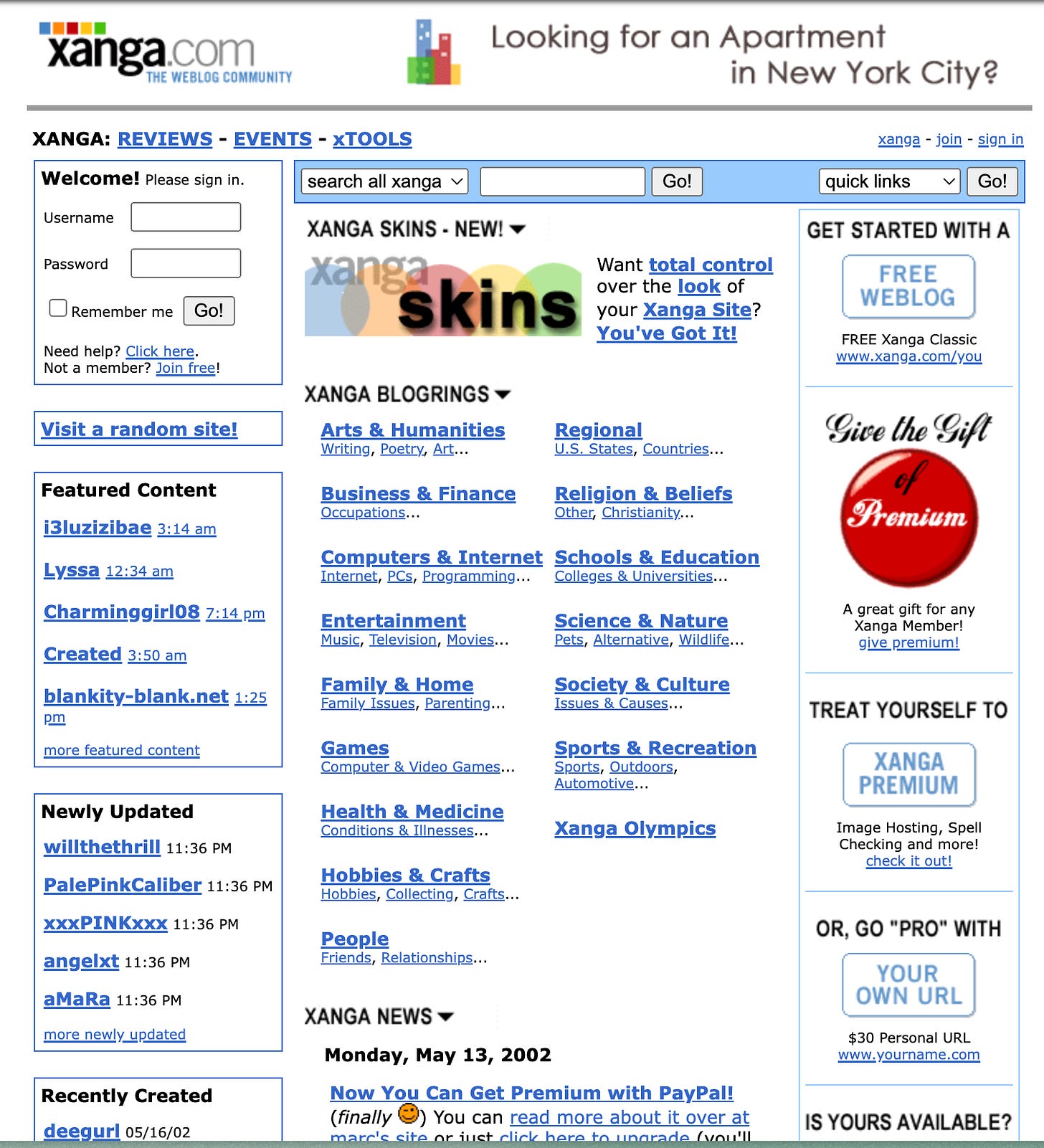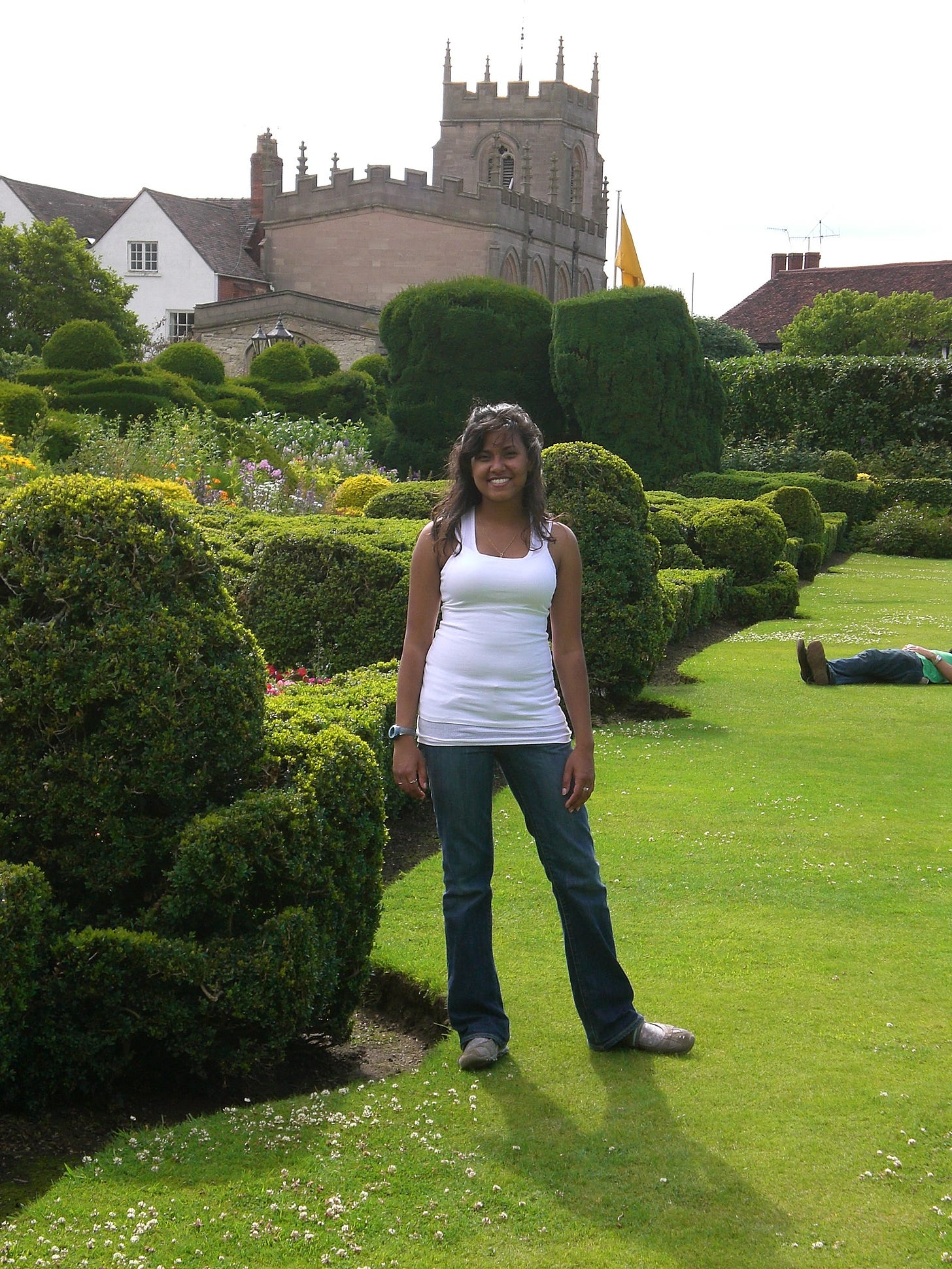After 45 days of publishing on Substack, I’ve learned that it’s hard for my content to be “found” on the internet, even in closed gardens like this platform. The algorithms are punishing and I’m having a really different experience than I had with blogging back in high school (over 20 years ago).
Below are seven lessons I’ve gleaned since I first posted here on May 4. I start with broad paradigm shifts, and finish with more specific strategies like SEO-related tricks I’ve learned.
Lesson 1: This isn’t Kansas anymore. No one just finds you on the internet.
I was an early adopter of blogging, and I used a platform so old it doesn’t exist anymore: Xanga. Ever heard of it? I started a blog there when I was 14 and posted pretty consistently.
In 2002, I shut down my Xanga after about six months because the audience grew too fast. I started having nightmares about being on stage naked. I was putting all my deepest darkest, adolescent insecurities on there, and lots of people were starting to read it. Back then the internet was small, and content was not yet ubiquitous.

I met interesting people through blogging in the early 2000’s. One Xanga friend was a guy from Cleveland who ended up going to my college (Ohio State University). We studied abroad together, backpacked around Europe, and even dated very briefly in my 20s. I don’t think all the internet algorithms were trying as hard back then, but they worked better in some ways.

When I first started Substack, I thought people would just find me. Like the way I was found 20 years ago. But that’s just not true anymore. It was naïve of me to think that would happen.
Lesson 2: Building an audience is challenging, but there are hidden rewards.
The intention for my Substack was never to grow a massive following. I just wanted a space to share my somewhat odd journey of going from being a lawyer to a science fiction novelist. I thought that writing a blog could be a way that I stayed connected with the world. I am not able to hole up in a cave for three years to write a novel. I need community.
But as I learn more about the book publishing industry, I’ve come to realize how critical it is to develop a broad audience for my writing long before my novel is ever released into the wild.
A decent following on Substack could help my book get published and sold. These days agents and publishers evaluate what kind of “author platform” a writer has built up before signing with one. A novelist with many followers has a built-in marketing machine for a book.
Lesson 3: Don’t be fooled by unrealistic promises and bad advice.
A few weeks ago, I wrote a ranty post about how everything I was reading on Substack seemed like ad copy for the writer’s expensive online course on growing Substack subscribers.
It’s off-putting when all the people who seem to be getting subscribers are doing it by selling snake oil. Do this one trick and you will have 1,000 followers overnight. Subscribe to learn the trick! Their big subscriber bases give these people fake credibility to sell the snake oil, but the way they got the subscribers is very suspect.
Those influencers also suck because they peddle the same general advice (probably generated by an AI) over and over again. It’s the usual: post at a regular cadence, engage with others’ posts, solve your reader’s problem, find a niche, use Notes, blah blah, blah. The advice can also be wrong. Influencers have varying opinions, for example, on whether finding a niche is necessary.
Despite my general dislike for this type of content, I sussed out a few such Substack “influencers” who I’ve found to provide useful advice.
Lesson 4: Craft better headlines and master newsletter writing.
Writing like I did as a lawyer, or as a novelist, or for a personal journal, or academic journal is very different from newsletter-writing. There are specific ways of writing on the internet that can grab a reader’s attention, sustain it, and cause them to act (like share the writing with friends). There are techniques for this type of writing, and I need to spend some time learning and practicing them.
I bit the bullet and became a paid subscriber to Sarah Fay’s Substack Writers at Work. By my initial assessment, her advice is legit. My biggest takeaways from her recent workshop on how to find dedicated followers are 1) have good headings, 2) write like you’re talking to a person (readers connect to your “voice”), 3) write guest posts on others’ stacks.
Lesson 5: Outsmart algorithms to drive more traffic from other platforms.
I’ve learned some tid bits here and there about how platform algorithms work from Tim Denning. I took a free* workshop he put on a couple weeks ago where he off-handedly remarked that posting Substack links to other platforms like LinkedIn fail because those platforms hate when you encourage their users to leave by posting links to elsewhere.
LinkedIn’s algorithm has been punishing me by not showing my posts in others’ LinkedIn feeds. One work around is to put the Substack link in the comments. But that’s still not the best (the algo still knows!), but it’s better than putting Substack links in the body of LinkedIn posts.
*And by Denning’s “free” workshop I mean it was a giant sales pitch to sign up for his very expensive course on how to grow large audiences on the internet. Despite the aggressive sales tactics, I still find valuable advice from Denning’s content so I would not put him in the snake oil salesman category.
Lesson 6: Optimize SEO by cross-posting on other platforms like Medium.
I’ve learned some basic information about SEO. If you’re not familiar, “SEO” stands for Search Engine Optimization. You can write your posts and include key words in a way that make them more likely to show up at the top of related searches on Google. Some websites like Medium also do a good job with under-the hood-formatting of posts (and other settings beyond my knowledge) to make them show up higher on search engines.
Because of Medium’s SEO advantage, I’ve decided to cross-post my Substack content on Medium as well. In addition to better SEO, I’ve read that Medium is a bit friendlier to newer writers. The folks that get big followings here on Substack are those that have been in the writing business for a long time (writing for magazines, newspapers, and freelancing) and have amassed huge audiences simply through their existing public persona.
Lesson 7: Canonical URLs are essential for SEO.
Cross posting my Substack content to Medium could tank my SEO rankings if I don’t do it right.
Search engines like Google penalize duplicate content. If content appears on multiple sites, search engines might not know which version to prioritize, potentially lowering the visibility of all versions. The way to get around this is to set a Canonical URL.
A Canonical URL is the “original” URL where the content was first posted. In Medium, there’s a way to update the settings of a particular post to establish that the content was first posted at a different site. This setting lets search engine algorithms know which content to prioritize for SEO ranking.
Substack doesn’t allow this setting, but Medium does. Here’s the Medium help page that describes how to do it.
A big thank you to my subscribers—I’m offering an AMA.
Thanks so much to my 42 subscribers! I really appreciate the space in your inbox and the time you take to engage in my world briefly each week. I aim to inform and delight.
To that end, I’m offering an “ask me anything” (AMA) post. Send me your burning questions (or light curiosity questions) in this Google sheet. Your questions can be about anything—they don’t have to be about Substack or writing.
I’ll keep this Google sheet open until June 30, and I’ll do my best to answer them fully and honestly in upcoming post(s).
See y’all next Tuesday,
Noor







I started blogging in 2010. I can confirm that growth was easier.
But I find it easier on Substack than on other platforms.
I combine:
Notes
Recommendations
Engaging with other people's content
And just this week I wrote a guest post.
Great advice! I’ve been doing a lot of what you’ve suggested here, and I’m seeing good results. I’m sure you’ll hit 365 in a year! I would say the other big thing that has really helped me is having other Substacks in my niche recommend my newsletter (and I do the same for them) - this has led to quite a few new subscribers.